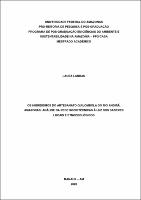| ???jsp.display-item.social.title??? |


|
Please use this identifier to cite or link to this item:
https://tede.ufam.edu.br/handle/tede/8019| ???metadata.dc.type???: | Dissertação |
| Title: | Os hibridismos do artesanato quilombola do Rio Andirá, Amazonas: análise da rede sociotécnica à luz dos saberes locais e etnoecológicos |
| Other Titles: | Hibridisms of the quilombolas handicraft in Rio Andirá, Amazonas: analysis of the sociotechnical network in the light of local and ethnoecological knowledge |
| ???metadata.dc.creator???: | Landau, Laura  |
| ???metadata.dc.contributor.advisor1???: | Schweickardt, Kátia helena Serafina Cruz |
| ???metadata.dc.contributor.referee1???: | Ranciaro, Maria Magela Mafra de Andrade |
| ???metadata.dc.contributor.referee2???: | Simão, Maria Olívia de Albuquerque Ribeiro |
| ???metadata.dc.contributor.referee3???: | Silva, Renato Izidoro da |
| ???metadata.dc.description.resumo???: | Todo grupo social está conectado à uma importante rede estruturada pela natureza, seres humanos e objetos técnicos resultantes do encontro dos dois primeiros. Comunidades tradicionais são grandes exemplos de como é possível para as sociedades comporem uma rede que respeita a cultura, identidade, modo de vida local e mundo natural. Este estudo teve como foco delinear a rede sociotécnica que sustenta a produção de objetos artesanais de comunidades quilombolas do Rio Andirá, localizadas no munícipio de Barreirinha, Amazonas. A pesquisa aconteceu especificamente em três comunidades: Santa Tereza do Matupiri, Ituquara e São Paulo do Açu, a fim de entender como seus atores se conectam e atuam. A identidade, território e modo de vida dos quilombolas se mostraram definitivos para o fazer artesanal, e a partir destes o conjunto casa-roça-mata-rio surge guiando as práticas do artesanato. Os objetos aqui estudados, vassoura, paneiro, peneira, tipiti e diversos artefatos de barro, são imprescindíveis para a garantia da subsistência familiar e resultam da relação dos artesãos com o conjunto. Os quilombolas reconhecidos como feitores, são aqueles cuja vida se organizou em volta do fazer. Se tornaram artesãos reconhecidos por seus pares a partir das práticas manuais desde crianças estimuladas, dos saberes tradicionais acumulados, da experiência na mata e rios e do engajamento com o material. O artesão se mostra um ator híbrido que é resultado da conexão profunda do quilombola com sua comunidade, com a natureza e com o material trabalhado. Os objetos que são criados por estes evidenciam a história daquele que faz, daqueles que o ensinaram, da relação etnoecológica com a natureza a volta, da comunidade e necessidades de seus membros. |
| Abstract: | Every social group is connected to an important network structured by nature, human beings and technical objects resulting from the meeting of the first two. Traditional communities are great examples of how it is possible for societies to compose a network that respects culture, identity, local way of life and the natural world. This study focused on delineating the sociotechnical network that supports the production of artisanal objects from the quilombola communities of the Andirá River, located in the municipality of Barreirinha, Amazonas State. The research took place specifically in three communities: Santa Tereza do Matupiri, Ituquara and São Paulo do Açu, in order to understand how their actors connect and act. The quilombola’s identity, territory and way of life shown to be definitive for artisanal making, and from these, the composition house-swidden-forest-river emerges guiding the practices of handicrafts. The objects studied here, broom, paneiro, manioc sifter, tipiti and various clay artifacts, are essential to guarantee family subsistence and result from the relationship of artisans with the group. Quilombolas recognized as feitores (makers) those whose life was organized around the making. They became artisans recognized by their peers based on manual practices, stimulated since childhood, accumulated traditional knowledge, experience in the forests and rivers and engagement with the material. The artisan is a hybrid actor, resulting from the quilombola's deep connection with his community, with nature and with the material manipulated. The objects that are created by them accumulate the history of the one who does it, of those who taught him, of the ethno-ecological relationship with the surrounding nature, the community, and the needs of its members. |
| Keywords: | Artesãos - Barreirinha (AM) Quilombos - Barreirinha (AM) |
| ???metadata.dc.subject.cnpq???: | CIÊNCIAS HUMANAS |
| ???metadata.dc.subject.user???: | Ator-rede Artesão Amazônia Campesinato Comunidade tradicional Quilombo rural |
| Language: | por |
| ???metadata.dc.publisher.country???: | Brasil |
| Publisher: | Universidade Federal do Amazonas |
| ???metadata.dc.publisher.initials???: | UFAM |
| ???metadata.dc.publisher.department???: | Centro de Ciências do Ambiente |
| ???metadata.dc.publisher.program???: | Programa de Pós-graduação em Ciências do Ambiente e Sustentabilidade na Amazônia |
| Citation: | LANDAU, Laura. Os Hibridismos do Artesanato Quilombola do Rio Andirá, Amazonas: Análise da rede sociotécnica à luz dos saberes locais e etnoecológicos. 224 f. Dissertação (Mestrado em Ciências do Ambiente e Sustentabilidade na Amazônia) - Universidade Federal do Amazonas. Manaus (AM), 2020. |
| ???metadata.dc.rights???: | Acesso Aberto |
| ???metadata.dc.rights.uri???: | http://creativecommons.org/licenses/by-nc-nd/4.0/ |
| URI: | https://tede.ufam.edu.br/handle/tede/8019 |
| Issue Date: | 16-Jun-2020 |
| Appears in Collections: | Mestrado em Ciências do Ambiente e Sustentabilidade na Amazônia |
Files in This Item:
| File | Description | Size | Format | |
|---|---|---|---|---|
| Dissertação_LauraLandau_PPGCASA.pdf | 17.61 MB | Adobe PDF |  Download/Open Preview |
This item is licensed under a Creative Commons License





